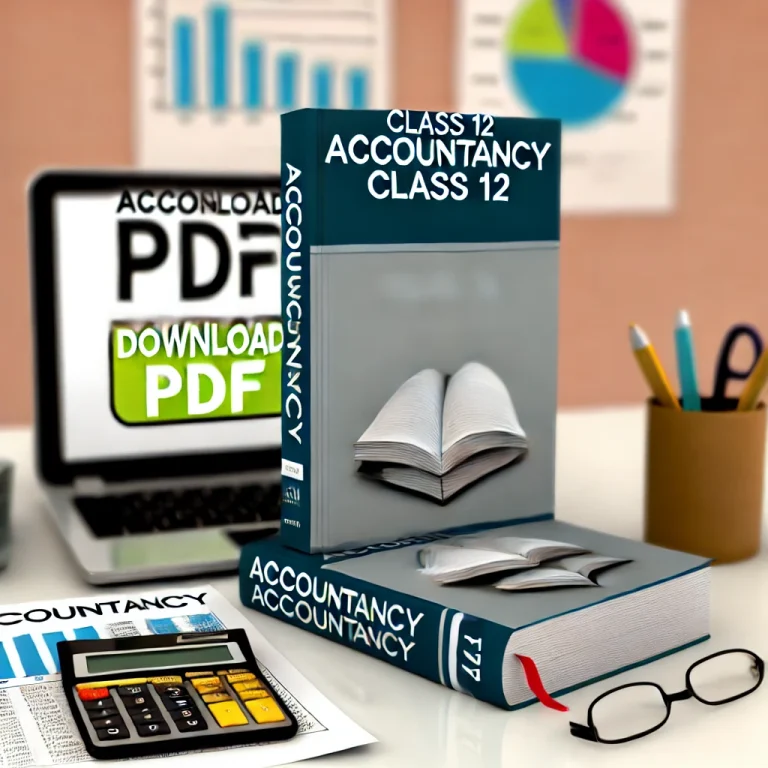The NCERT accountancy book class 12 is a resource that provides the most standardized way of understanding complex accounting concepts very simply. The book consists of two parts that include all elements, from basic accounting principles to corporate accounting and financial statement analysis. Thus making it suitable for both beginners and learned scholars. The NCERT Accountancy book for Class 12 structures well, building on the concepts in a clear-cut manner. These align with the curriculum of CBSE and today’s industry standards.
Accountancy Book Class 12 PDF Free Download
The NCERT Books for Class 12 Accountancy contain topics such as accounting principles, partnership accounts, and financial statement analysis. The NCERT book provides quality knowledge of accounting principles and helps students shine in exams. Students can download the NCERT Book for Class 12 Accountancy in English and Hindi. Get the link to download the Class 12 Accountancy Book PDF for Part 1 and Part 2 from the table below.
| Download PDF for NCERT Class 12 Accountancy Book | |
| NCERT Books for Class 12 Accountancy Part 1 in English | Download PDF |
| NCERT Books for Class 12 Accountancy Part 2 in English | Download PDF |
| NCERT Books for Class 12 Accountancy Part 1 in Hindi | Download PDF |
| NCERT Books for Class 12 Accountancy Part 2 in Hindi | Download PDF |
Class 12 Accountancy Chapters PDF Free Download
Looking to ace your Accountancy studies? Downloading NCERT Accountancy chapters in PDF format is a great way to have all the essential material at your fingertips. Whether preparing for exams or brushing up on concepts, the NCERT Accountancy PDFs provide structured, easy-to-understand content to help you master the subject. You can quickly access and revise key topics anytime, anywhere. Download the chapters and start your journey to success with these free downloadable resources.
| Download PDF for NCERT Class 12 Accountancy Part 1 Chapters | |
| NCERT Accountancy Part 1 Chapter 1 | Download PDF |
| NCERT Accountancy Part 1 Chapter 2 | Download PDF |
| NCERT Accountancy Part 1 Chapter 3 | Download PDF |
| NCERT Accountancy Part 1 Chapter 4 | Download PDF |
| NCERT Accountancy Part 1 Chapter 5 | Download PDF |
Downloading the NCERT Accountancy Part 2 chapters in PDF format is an excellent way to stay organized and focused. These PDFs offer comprehensive coverage of all important topics, making revision easier and more efficient. Whether you’re studying balance sheets, financial statements, or other important chapters, these resources provide clear explanations and examples. Access and revise NCERT Accountancy Part 2 chapters anytime, anywhere, and boost your preparation for success.
| Download PDF for NCERT Class 12 Accountancy Part 2 Chapters | |
| NCERT Accountancy Part 2 Chapter 1 | Download PDF |
| NCERT Accountancy Part 2 Chapter 2 | Download PDF |
| NCERT Accountancy Part 2 Chapter 3 | Download PDF |
| NCERT Accountancy Part 2 Chapter 4 | Download PDF |
| NCERT Accountancy Part 2 Chapter 5 | Download PDF |
| NCERT Accountancy Part 2 Chapter 6 | Download PDF |
NCERT Accountancy Textbook for Class 12 Part 1: Chapter-wise Details
The NCERT Accountancy Textbook for Class 12 Part 1 systematically familiarizes students with higher accountancy principles and practices. Each chapter discusses specific accounting areas, like preparation of financial statements, not for profit organizations’ accounts, and partnership accounts. The book uses Class 11 fundamental knowledge to improve students’ comprehension and ability to perform complex accounting activities.
Chapter 1: Not for Profit Organization Accounting
Chapter 1 of the NCERT Class 12 Accountancy Part 1 book discusses the financial activities of not-for-profit organizations, which include charities, trade unions, government institutions, and public sector organizations. The chapter elaborately discusses the accounting techniques employed by these organizations using specialized accounts such as the receipt and payment account and the income and expenditure account and describes their respective characteristics with exactness.
The chapter further explores the topics of subscriptions (revenue earned as membership fees) and capital funds (assets beyond liabilities). These accounting components are explained in clear terms, with corresponding practice problems that assist students in reinforcing their grip on the accounts and concepts presented to them, with a better overall understanding of the accounting procedures for not-for-profit entities.
Chapter 2: Partnership Accounting
Chapter 2 of the NCERT Class 12 Accountancy book discusses the partnership accounting process, wherein two or more persons or entities join together to conduct business. The chapter begins with defining a partnership deed and its importance, followed by a discussion of the most important features of a business partnership.
This chapter also describes the fixed and fluctuating capital concepts in partnership accounts. It also discusses profit and loss adjustments, the different provisions of the Indian Partnership Act 1932, and accounting treatments for scenarios like a partner withdrawing income, guarantees of profit to a partner, and modifications in the profit-sharing ratio. These aspects give a complete picture of the intricacies of partnership accounting.
Chapter 3: Reconstitution of a Partnership Firm: Admission of a Partner
Chapter 3 of the NCERT Class 12 Accountancy textbook thoroughly describes the adjustments to be made when a new partner enters a partnership firm. This chapter discusses creating a new profit-sharing ratio among existing partners to accommodate the new member.
Important concepts like the sacrificing ratio—its importance, computation, and use—are discussed in depth. The chapter also discusses the concept of goodwill, the determinants of its value, and different methods of its valuation in the case of a partnership. Every important topic is followed by situational questions to make students understand the intricacies of reconstituting a partnership.
Chapter 4: Reconstitution of a Partnership Firm: Retirement/Death of a Partner
Chapter 4 of the NCERT Class 12 Accountancy Part 1 textbook discusses the steps and consequences involved in the retirement or death of a partner in a partnership firm. The chapter begins by discussing the different modes of a partner’s exit from the partnership and the changes that must be made in the firm’s accounts.
A detailed table in the chapter compares and contrasts the sacrificing ratio with the gaining ratio when a partnership is considered. The discussion also includes the necessity of revaluing assets and reestimating liabilities after the retirement or death of a partner. The chapter also describes how accounts are settled with a deceased or retired partner and gives a complete overview of how such situations are managed in a partnership firm.
Chapter 5: Dissolution of Partnership Firm
Chapter 5 of the NCERT Class 12 Accountancy book explains the distinction between the dissolution of a partnership and the admission of a partnership firm, emphasizing the specific legal and financial consequences of each. The chapter offers thorough accounting treatments of unrecorded assets and liabilities so that students know how to treat these components during dissolution.
The chapter’s discussions also explain the difference between a partner’s and a firm’s debts and the functions of the revaluation and realization accounts in dissolving a firm. The chapter further addresses settling the creditors’ claims when a firm dissolves. The chapter concludes with practice problems to apply what students have learned regarding partnership firms’ dissolution.
NCERT Class 12 Accountancy Textbook Part 2: Chapter-wise Details
The NCERT Class 12 Accountancy Textbook Part 2 develops students’ knowledge of advanced accountancy concepts, emphasizing company accounts and financial statement analysis. Every chapter systematically dissects subjects like accounting for share capital, debentures, and financial statement analysis, preparing students to address real-world financial issues effectively.
Chapter 1: Share Capital Accounting
Chapter 1 of NCERT Class 12 Accountancy book Part 2 properly familiarizes students with the fundamentals of company organizations, including differences between listed, public and private companies and how they work. Chapter 1 explores significant points about share capital, such as:
- Call in Arrears and Calls in Advance: Managing delayed and advance payments of share capital.
- Minimum Subscription: Minimum amount that needs to be raised through issued shares to begin business operations.
- Types of Shares: Differentiating the equity and preference shares.
- Oversubscription and Undersubscription: How excess or shortfalls of share applications are handled.
- Forfeiture of Shares: Penalty for shareholders who do not meet the time limits for payment.
It classifies share capital as authorized, issued, subscribed, and paid-up capital, among others, and it understands each category’s function in corporate finance. The chapter also provides an understanding of the subtleties of preference shares, improving students’ comprehension of intricate financial instruments in corporate environments.
Chapter 2: Issue and Redemption of Debentures
Chapter 2 of the NCERT Class 12 Accountancy Part 2 textbook discusses the financial instrument debenture. The chapter first defines debentures and then classifies them according to their characteristics: bearer, irredeemable, convertible, and mortgage debentures. It discusses the major features that can distinguish debentures, such as:
- Security: The property that secures the debenture.
- Tenure: The term for which the debenture is issued.
- Mode of Redemption: How the debenture would be redeemed.
- Coupon Rate: The rate of interest payable to the debenture holders.
- Registration: The formal entry of the debenture issue into the records.
The chapter also deals with advanced topics such as issuing debentures as collateral security, dealing with the issuances of debentures for non-cash considerations, and the accounting treatment of issuing debentures at a discount but redeeming at a premium. It also encompasses redemption of debentures out of the capital and through open market purchases and a detailed comparative table indicating the contrasts between debentures and shares. Such discussions provide students with a thorough understanding of the nuances of debenture issues and redemption.
Chapter 3: Financial Statements of a Company
This chapter of NCERT Class 12 Accountancy contains a detailed discussion of financial statements, explaining purpose, contents, and intrinsic limitations. The chapter describes the different aims of financial statements and their relevance to different parties like shareholders, creditors, government authorities, and investors. The chapter stresses using financial statements to provide stakeholders with the essential information to make well-informed decisions.
The chapter also explores how tools, debentures, and dividends are accounted for on a firm’s balance sheet and the subjective nature of financial statements determined by recorded facts, accounting conventions, and individual judgments. Furthermore, it includes practical exercises with the participation of students in preparing vital financial reports like profit and loss statements, balance sheets, and income statements. The exercises aim to take students to a higher level of competency in dealing with real accountancy tasks, as well as their analytical skills and understanding of corporate financial reporting.
Chapter 4: Financial Statement Analysis
Chapter 4 of the NCERT Class 12 Accountancy textbook educates students on financial statement analysis methods and techniques. This chapter discusses a thorough list of tools of analysis, including:
- Comparative Financial Statements: These compare financial information from different periods to indicate trends and alterations.
- Common Size Statements: This approach standardizes financial statements by representing all items as a percentage of a base figure to enable comparisons.
- Trend Ratios: These examine the pattern of movement of certain financial figures over time to determine trends.
- Average Analysis: This method computes average figures of financial information for enhanced trend detection.
- Statement of Changes in Working Capital: Monitors changes in working capital to determine a company’s operational efficiency.
- Fund Flow Statement: Indicates company financial position changes over two balance sheet dates.
- Cash Flow Statement: Studies cash inflows and outflows to analyze a company’s liquidity.
- Ratio Analysis: Applies standard ratios to review various aspects of the performance and health of a company.
- Cost Volume Profit Analysis: This is used to determine the correlation between costs, the volume of sales, and profit.
The chapter is supported by an elaborate table distinguishing horizontal and vertical analysis to aid students in comfortably understanding the terms. The chapter also explores how financial analysis assists in business decision-making.
Chapter 5: Accounting Ratios
Chapter 5 of the NCERT Class 12 Accountancy textbook provides a detailed discussion on ratio analysis, a key instrument for analyzing financial statements. This chapter discusses a wide range of ratios that are vital in assessing the financial condition of a company, such as:
- Profitability Ratios: These assess the capability of a company to earn relative to its revenue, assets, and equity.
- Ratios of Coverage: These determine a company’s capacity to service its debt and fulfil its financial commitments.
- Ratios of Turnover: These measure the efficiency of utilization of a company’s assets.
- Financial Ratios: These give information regarding the financial composition of the company, such as its liquidity, solvency, and leverage.
- Ratios of Control: These aid in tracking some operational efficiencies.
The chapter extensively deals with calculating and analysing important operational ratios such as inventory turnover, trade receivables turnover, trade payables turnover, and working capital turnover. It also elaborately explains current and liquidity ratios. It aids in determining the capability of a company to repay short-term debts.
In addition, the operations of different profitability ratios are explained in detail. This will enable students to efficiently calculate and compare firms’ profitability. The chapter contains problems and examples that direct students to calculate various ratios. Thus, improving their practical knowledge and analytical skills in financial accounting.
Chapter 6: Cash Flow Statement
Chapter 6 of NCERT Class 12 Accountancy deals with the cash flow statement, an essential aspect of business financial reporting. This chapter opens with a definition of a cash flow statement in straightforward and brief language and outlines several uses of the company’s financial condition. The purposes of preparing a cash flow statement are explained in detail, emphasizing its significance in monitoring cash inflows and outflows from operating, investing, and financing activities by the amended accounting standard (AS) 3 provisions.
The students are directed through the preparation of a cash flow statement, beginning with categorizing various types of activities to determining net cash flows from operating activities. The chapter also explains the significant sources and applications of cash in investment activities, clearly showing how cash is earned and disbursed in a business environment. This chapter will give students the skills to prepare and interpret cash flow statements proficiently. It gives them applicable knowledge in actual financial analysis.
Advantages of Using NCERT Books for Class 12 Accountancy
NCERT Class 12 Accountancy books have several benefits that are specifically useful for board exams and comprehending intricate concepts:
- Easy Language: The books use simple language, making it easy to understand complicated concepts and developing students’ problem-solving abilities.
- Synchronization with CBSE Curriculum: These textbooks are carefully developed under the existing CBSE syllabus to ensure that everything contained therein is in harmony with what needs to be covered by the students in their examinations.
- Preparation for Board Exam: Large numbers of CBSE board questions are either written exactly from NCERT textbooks or are inspired by situations described within NCERT textbooks. Those aware of NCERT textbooks perform better in exams as even the most muddled questions become easy to crack for them.
- Competitive Exam Foundation: NCERT books serve as a sound foundation for several competitive exams by offering an in-depth insight into fundamental principles of accountancy.
- Practice Material: Every chapter has questions and problems at the end that enable students to try their level of understanding and prepare well for their exams. The exercises go from simple to difficult, encompassing all areas covered in the chapter.
Class 12 Accountancy Book NCERT FAQs
What topics are covered in NCERT Accountancy Book Class 12?
The NCERT accountancy book class 12 covers essential topics such as partnership accounts, company accounting, financial statement analysis, and not-for-profit organization accounting, all crucial for CBSE exams.
Is NCERT Accountancy Book Class 12 sufficient for board exams?
The accounts ncert book class 12 is highly recommended for board exams as it aligns with the CBSE curriculum, covering all necessary concepts and providing ample practice.
Where can I download Class 12 Accountancy Book PDF for free?
The NCERT Class 12 Accountancy Book PDF can be downloaded from the official NCERT website. These are available for free in Hindi and English as well. You can also get the download link provided above in this article.
How many Accountancy books does NCERT publish?
NCERT publishes Accountancy books for class 12 CBSE students in two sets. The first book is based on Partnership Accounts, while the second book has chapters related to Company Accounts and Analysis of Financial Statements. The syllabus has been classified into two books based on the concept differences.


